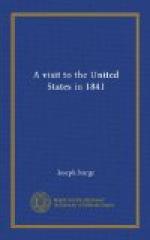“All the proceedings in the matter, on the part of both the executive and judicial branches of the government, have had their foundation in the assumption that Montez and Ruiz alone were the parties aggrieved; and that their claim to the surrender of the property was founded in fact and in justice.”
The Spanish minister and his successor, complained bitterly, in the course of a long correspondence, of the delay in giving up the Africans, on the ground, as emphatically stated in one of their letters to the Department of State, that “the public vengeance had not been satisfied; for be it recollected that the legation of Spain does not demand the delivery of slaves, but of assassins.” In a previous communication it was intimated that “the infliction of capital punishment in this case (in the United States,) would not be attended with the salutary effects had in view by the law, when it resorts to this painful and terrible alternative, namely, to prevent the commission of similar offences.” Notwithstanding these dreadful intimations of the fate awaiting the Africans in Cuba, the American Government deliberately adopted the design of delivering them up, either as property or as assassins. That Government found willing agents in the United States’ Marshal, and the District Attorney of Connecticut. The following extracts from the argument of John Quincy Adams, will explain these disgraceful transactions:
“On the 7th of January, the Secretary of State writes to the Secretary of the Navy, acknowledging the receipt of his letter of the 3d, informing him that the schooner Grampus would receive the negroes of the Amistad, ’for the purpose of conveying them to Cuba, in the event of their delivery being adjudged by the Circuit Court, before whom the case is pending.’ This singular blunder, in naming the Court, shows in what manner and with how little care the Department of State allowed itself to conduct an affair, involving no less than the liberties and lives of every one of my clients. This letter enclosed the order of the President to the Marshal of Connecticut




